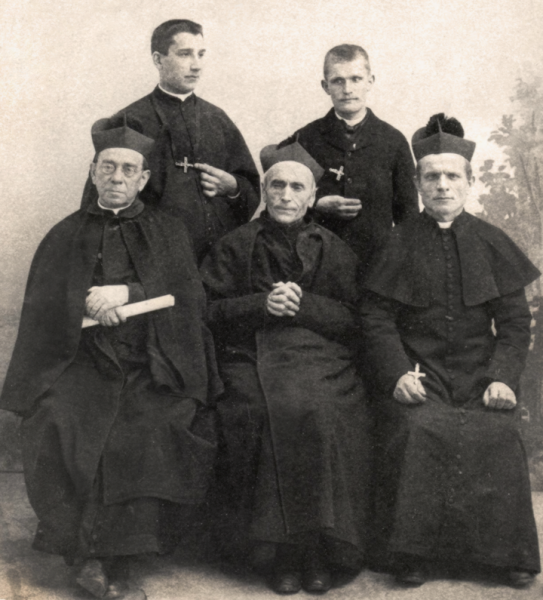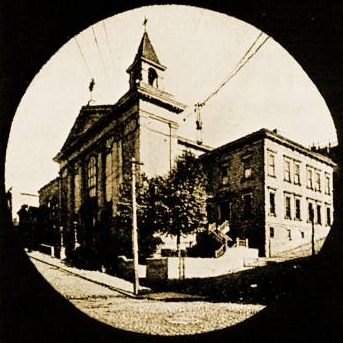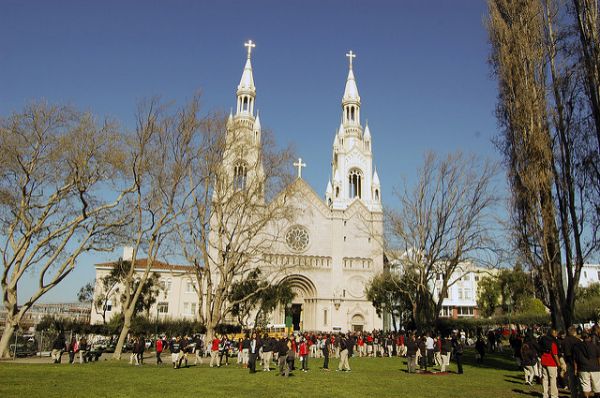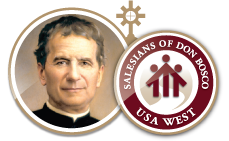Salesians Coming to America: The Man Who Led the Way (From Turin, Italy to San Francisco, California)
One winter afternoon in 1897, Angelo Petazzi, a young Italian immigrant of 21 who peddled fruit and vegetables for a living in the back streets of Boston, was anxiously awaiting the arrival of the English steamship, Werra, that was scheduled to dock in New York harbor.

(Pictured above: The first Salesians sent by Don Rua from Turin, Italy to the United States; Seated left to right: Fr. Raphael Piperni, leader of the expedition; Blessed Michael Rua, St. John Bosco's successor; Fr. Valentino Cassini; Standing: Seminarian Brother Joseph Oreni; Coadjutor Brother Nicholas Imielinski. It is also interesting to note that Fr. Piperni is holding the letter from Don Rua that will accompany his sons to America, you can read that letter here: http://www.donboscowest.org/province/archives/featured-don-rua-letter)
Clutched in his hand was a letter from the then Salesian superior general, Father Michael Rua. It informed him of the impending arrival of a group of four Salesians. At their head was Father Raphael Piperni. In his letter to Petazzi, who was serving as a welcoming committee of one, Father Rua had asked him to meet the small band of Salesian missionaries in his name, and to escort the group across the American continent to their destination, San Francisco, California.
Two weeks later, shortly after his arrival in San Francisco, Father Piperni would write a lively account of his eighteen day Atlantic crossing and his group's transcontinental trip to San Francisco for the Italian version of The Salesian Bulletin. The ocean voyage, he wrote, had gone swimmingly ("Nostro viaggio fù felicissimo"). Happily the group was spared the lengthy grueling processing at Elise Island. Piperni explained that since they were missionaries and therefore not considered immigrants, "we did not have to put up with all that troublesome routine."
The train trip from New York to San Francisco (which included a two-day stopover in Chicago) took ten days. Though it was still winter, the passengers experienced no discomfort. "We did not feel the cold at all," wrote Father Piperni later, "since the spacious coaches were well heated by steam." But the purple mountains and the fruited plains of America left no apparent impression upon him: "Most of our trip through desert and snow-capped mountains was somewhat boring."
Waiting for the new arrivals in San Francisco was the pastor of the Italian church of Saints Peter and Paul, the secular priest, Father Raphael De Carolis. Their meeting was a cordial one. On the following day, March 13, 1897, the two priests were ushered into the presence of Patrick. W. Riordan, Archbishop of San Francisco, who had appealed at length with Father Rua to send Salesians to care for the neglected Italian immigrants of North Beach. That historic encounter took place in the archdiocesan chancery office located at 1100 Franklin Street. The present Salesian provincial residence is now located on that identical spot.
Who were those first four Salesians that arrived in the city of Saint Francis a century ago? Included in Father Piperni's little band was: Father Valentino Cassini, who had studied at the Valdocco Oratory, and who left us a vivid vignette of Don Bosco's later years.
One evening after the tables had been cleared and the dining room was vacant, the kitchen was informed that a priest had arrived very late for dinner. The cook exploded in anger at the late arrival. When informed that the Salesian was Don Bosco, he shouted for all to hear: "So what! Don Bosco is like everybody else!" and he ladled him out a dish of cold and overcooked rice. Cassini never forgot how the priest accepted the cook's outburst: "He's right, you know, and what he said is true. There is no reason why Don Bosco should not be treated like everybody else." And he sat down to a cold supper that night.
Several years after his arrival in San Francisco, Father Cassini was asked to take over the mission parish of Corpus Christi. In 1903 he left California for Argentina. He died in Buenos Aires in 1922.

Pictured above: The first church of Saints Peter and Paul located at the corner of Dupont Avenue and Filbert Street, built in 1884. Photo appeared in that year's Christmas issue of the Catholic Monitor.
Also in the group was the seminarian Joseph Oreni, 23. Three years after his arrival Oreni was ordained in 1900, making him the first priest of the Salesian Society ordained in North America. His stay in California was short-lived. In the following year he was transferred to Venezuela to serve the Italian immigrants there.
Polish lay brother Nicholas Imielinski, affectionately known as "Brother Nick," was the fourth member of the missionary band. He would serve as sexton of SS. Peter and Paul's church for half a century. Bro. Nick died in San Francisco in 1948, 51 years after his arrival in the "City by the Bay." Blessed with an enormous capacity for patience, he is still remembered with fond affection by some old timers (including the writer) as a sweet, saintly, and totally unflappable gentleman who like a religious Clyde Beatty could subdue into silence a cage-full of riotous altar boys by simply raising a finger to his lips.
Then there was Father Raphael Piperni (18421930), a contemporary of Don Bosco. However, unlike most of the Salesian missionaries who established the Salesian work in foreign lands, he was not a product of the Founder's Valdocco Oratory--nor, for that matter, of any of the first Salesian schools. Piperni was ordained a priest for the Diocese of Campobasso, south of Rome, and taught in several diocesan ginnasi [high schools] before responding to the call of the missions. As he wrote in his memoir: "I was convinced that I did have a missionary vocation, and after a year's preparation and training, I was sent by the Propaganda Fide to the Holy Land."
From the very start Palestine captivated Father Piperni's heart. There he soon joined the Brothers of the Holy Family, a religious congregation founded by Canon Antonio Belloni. It was Belloni who recognized Father Piperni's remarkable talent for fundraising. This gift was put to work as Piperni's fundraising tours took him to France, Belgium, England, Ireland, Canada, and eventually to the United States. By the time he reached San Francisco (not as a Salesian, but as a member of the Brothers of the Holy Family), he had become a seasoned traveler and his efforts on behalf of the Brothers' foundations in Palestine were more than amply rewarded. Canon Belloni himself attested that it was Father Piperni's regular life-saving bank drafts from abroad that enabled his little congregation to stay afloat.
Father Piperni's final destination was Mexico City where he enjoyed the esteem of the Archbishop. Although he was not conversant in Spanish at that time, still his fundraising efforts exceeded all expectations. He noted in his memoir: "Though a poor nation, the generosity of the Mexican people was overwhelming. And many contributed from their want." After 13 years of what he called his "years of wandering" (anni di peregrinazione), the weary traveler decided it was time to return home. The year was 1891.
But it was not a happy homecoming. The lack of religious vocations forced founder Antonio Belloni, with Rome's approval, to disband his congregation and to merge it with the Salesian Society. On October 8, 1892, Father Piperni professed as a Salesian and was assigned to Mexico where the Salesians had recently opened their first institution. Back in the country he was greatly loved, he was soon made director of the Salesian trade school in Puebla. Three years later he was summoned to Turin by Father Michael Rua and entrusted with the founding of the first Salesian work in North America.
The U.S. Weather Bureau recorded that the weather on Sunday morning, March 13, 1897, was cold and rainy with high winds buffeting the waters of San Francisco Bay. It proved to be an omen of things to come. Father Piperni found the Italian community in North Beach in the grip of vicious anticlerical hotheads. Moreover, the lot of the Italian immigrants in San Francisco was not a happy one. Just as half a century earlier the arrival of great numbers of Catholic Irish, Poles, and Germans had borne the brunt of harsh discrimination and intolerance, it was now the Italians' turn. Their presence on American soil resurrected a new version of anti-Catholic nativism.
Father Joseph Simeoni, in a testimonial describing the early years of his assignment at SS. Peter and Paul's church, recounted details of his own arrival in San Francisco. He was warmly welcomed by Father Piperni, brought to the parish house, where a bountiful dinner awaited him. After dinner, Father Piperni left the dining room went to a cupboard and returned with both hands full of stones and small rocks. He then lined them up on the table for everyone to see. "These," he said are just few of the stones that have been recently thrown at me while I was walking down Dupont Street--a street, by the way, which I strongly urge you to avoid." "That," recalled Father Simeoni, "was my introduction to the parish of SS. Peter and Paul."
The display of those guided missiles was not an idle gesture. The lot of Father Piperni and the first Salesians in the city of Saint Francis during those early years was not one of loving welcome, so often associated with San Francisco's patron saint. For example, soon after the Salesians began their ministry in North Beach, shadowy figures, under cover of night, would scrawl obscenities on the walls of the church, and nail scurrilous cartoons on its doors for the sole purpose of discrediting the Church and vilifying its priests. Father Piperni would get up in the early morning hours, and with his faithful sexton, Bro. Nick, in tow with a bucket of hot water, soap, and a scrub brush, would wash away the hate slogans and offensive drawings before the faithful arrived for morning Mass.
Father Piperni's accomplishments as pastor of SS. Peter and Paul spanned more than 30 years. No doubt, he will always be remembered as the man who, against all odds, was responsible for the construction of the magnificent church of SS. Peter and Paul now facing Washington Square. The original wooden church on Dupont Street had been reduced to ashes during the 1906 fire and earthquake which had wiped out much of the city of San Francisco. Father Piperni recalled that devastating event in his memoir:
"On April 18, three days after Easter, San Francisco was in flames. Two days later, the conflagration reached us, and our rectory and church were swept away by fire. For weeks we spent all our time visiting and comforting those in our community who had taken refuge in tents which had been pitched in the fields and small parks that the fire had not reached."
Phoenix-like a new and imposing church began to rise from the ashes. But it was slow-going. First the crypt of the church, which served as the parish center for several years, was built. Construction on the new church did not begin until 1913. Work soon bogged down because financial help was a continual problem. Four bomb attempts by fanatical anarchists slowed, but did not deter, the completion of the church. Finally, on May 23, 1927, Father Piperni experienced the joy of blessing the tower chimes which put the finishing touch on his "Italian Cathedral of the West."

(Pictured above: Saints Peter and Paul Church today in North Beach of San Francisco, California)
On the following day, May 24, the entire city of San Francisco joined him in celebrating the 60th anniversary of his ordination. This gala event which highlighted Father Piperni's diamond jubilee also marked the end of his long odyssey. Thirty years before he had come to San Francisco expecting the worst, and he got it. But now they were no longer throwing brickbats at him but bouquets. At age 85, ailing and feeble, he asked to retire to the newly opened junior seminary across the bay in Richmond. On November 12, 1930, Father Piperni was stricken with pneumonia and rushed to the hospital. Three days later he died. He was 88.
When the bells of the twin towers of his beloved church tolled the sad announcement of his passing, the press was loud in his praise. But it was William Randolph Hearst's San Francisco Examiner that perhaps said it best:
"A great missionary has died in San Francisco--Father Raphael Piperni. To the young generation he was just a feeble old priest. To the discerning and more mature readers he was a man who in his last years was rapt in divine contemplation. If the truth be told, Father Piperni is the Salesian who saved the Italians in Northern California for the faith. Other men worked valiantly with him, but the humble concede to him the guerdon for starting the fight when he had to start it against all odds. He was truly a man of great faith."
--
The original title to this write-up is "Coming to America: The Man Who Led the Way" by Fr. Michael Ribotta, SDB. Fr. Michael Ribotta, SDB has taught at the Dominican School of Philosophy and Theology at the Graduate Theological Union in Berkeley as an adjunct Professor for the Institute of Salesian Spirituality. He holds a PhD in Education from the University of California, Berkeley.

